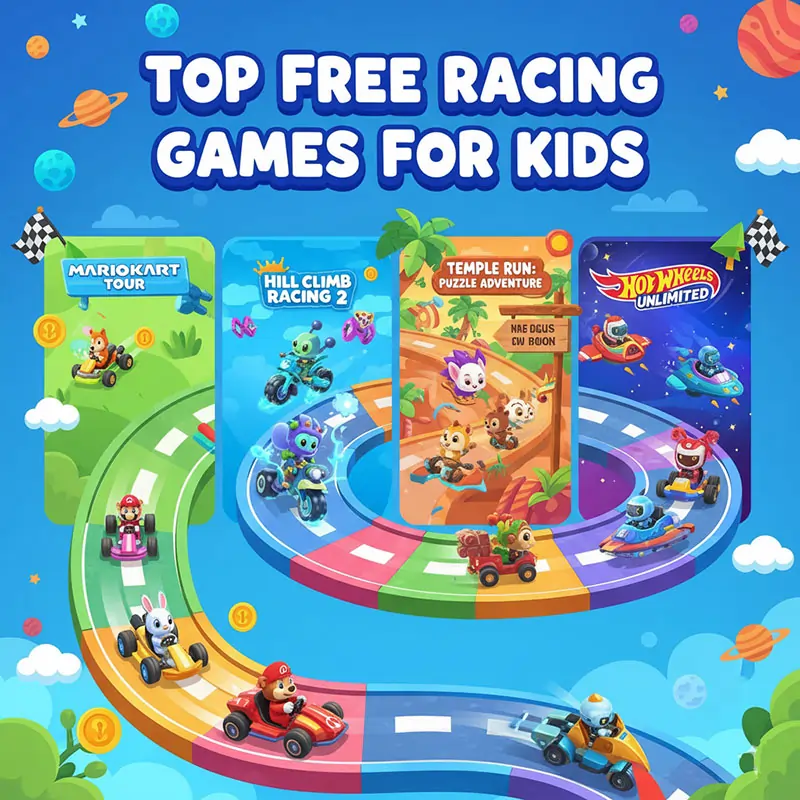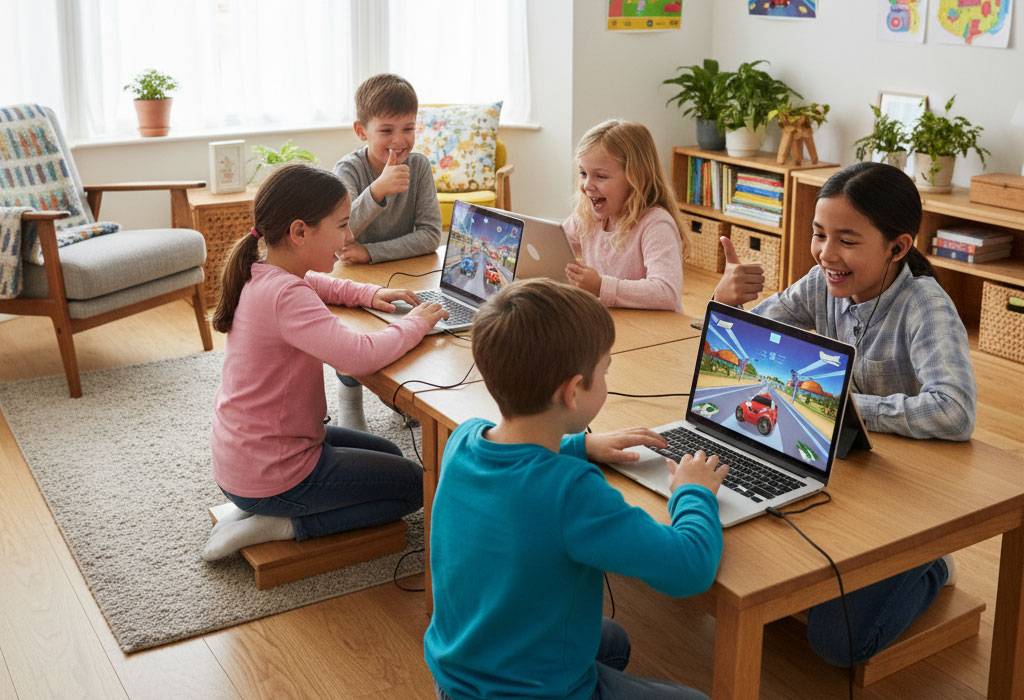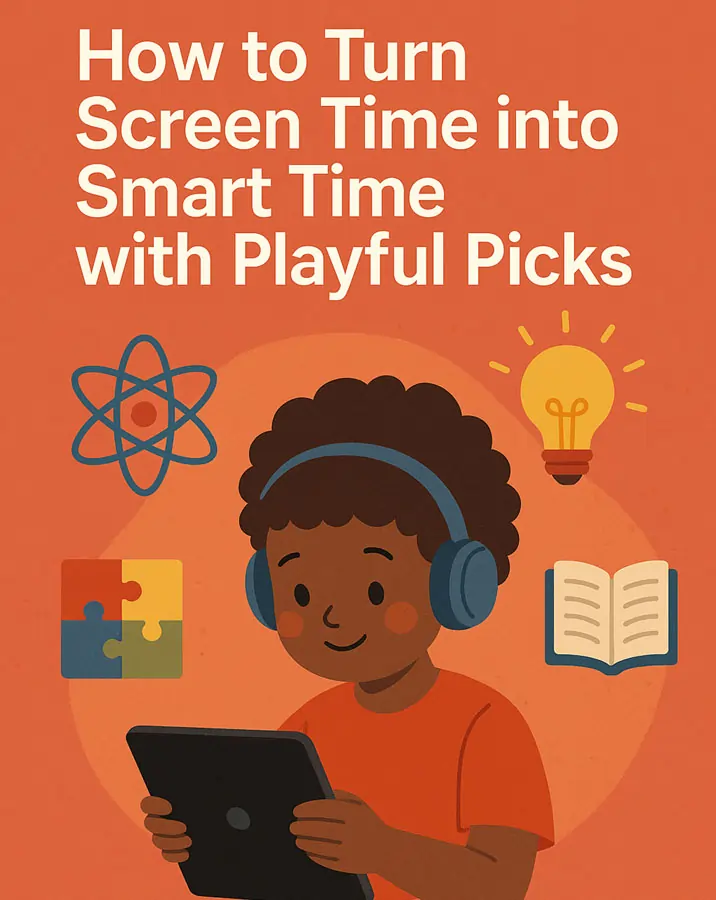Kids’ Racing Games: Every Lap Is Exciting, Fast, And Educational
Have you ever witnessed the joy on a child’s face as they reach the end of a video game? It is absolute ecstasy when the engine sounds thunder, the colors flash, and the triumph song plays.
It’s not only about speed in racing games. They are about planning, focus, and learning in a fun and covert manner. Youngsters like this stuff, whether it’s racing motorcycles, cars, or animals in imaginary worlds. They are instantly captivated by the sense of motion and achievement.
The problem is that racing games have evolved significantly since they were just focused on winning. They are now instruments that assist children have fun while simultaneously developing their coordination, reflexes, and strategic thinking. The kid-friendly online racing environment is safer, more entertaining, and more educational than the arcade games we once played.
1. The Reasons Children Adore Racing Games
Children are designed for speed. We are deeply affected by the sensation of movement, control, and excitement. They can drive fast automobiles in racing games with no risk. You have the opportunity to experience immediate excitement and accomplishment with each lap. This blend is quite enticing.
However, it’s not only that. The essence of these games lies in people’s innate curiosity and drive for success. When given the freedom to explore, make snap judgments, and receive immediate feedback, children learn best. Attempting, failing, adapting, and succeeding is a process that enables you to learn without feeling like labor.

2. There Are Various Types of Racing Games, Such As Virtual Racers, Motorbikes, Cars, And Animals
A wide variety of racing games are available. Despite the popularity of racing cars, there is a surprising range of games that appeal to kids of all ages and skill levels.
a) Racing Car Games
In Car racing games, the tracks are entertaining, the cars are colorful, and the controls are simple. Everything from go-karts to large trucks can be raced.
- In SuperToys Racing, tiny cars compete on toy racecourses. Kids will feel fantastic, and adults will remember the past.
- Crazy Kart Adventure combines gymnastics, such as jumps, flips, and crashes, with racing to make kids laugh rather than cry.
b) Games for Racing Bikes
Children who enjoy riding motorcycles should learn how to balance and steer. Bike activities that test coordination include bumps, jumps, and obstacle courses.
- There are cartoon-inspired bike maneuvers in Moto X3M for Kids. No one is harmed, helmets are required, and there are safe wrecks.
- For young children, Tiny Biker Race is an entertaining game where they can fall, laugh, and try again.
C) Racing Games with Animals
For younger children, animal-themed racing relies on their imaginations rather than engines. Hearing vehicles roar is far more frightening than seeing dinosaurs, turtles, and bunnies scurrying through forests or other picturesque settings.
- There are magical ponies racing in Pony Race 3D, and there are no exhaust fumes.
- In Dino Dash, dinosaurs battle on volcano-shaped tracks. It’s entertaining and beneficial for kids because they learn dinosaur names while they play.
d) Virtual Racer Games
Dragons, rockets, magic brooms, and everything else children might imagine that they enjoy reading about are all included in fantasy racing. Because these activities are entertaining and imaginative, learning becomes an experience.
| Type of Racing Game | Example Game | Age Group | Learning Outcome |
| Car Racing | SuperToys Racing | 5–10 years | Hand-eye coordination |
| Bike Racing | Moto X3M for Kids | 6–12 years | Balance and control |
| Animal Racing | Dino Dash | 3–7 years | Imagination & role play |
| Fantasy Racing | Magic Kart Quest | 7–12 years | Creativity & storytelling |
3. You May Improve Your Coordination, Reaction Time, And Focus By Playing Racing Games
Despite their perception that they are merely playing racing games, children are actually learning valuable lessons.
a) Coordination Between the Hands and the Eyes
Your brain and body will cooperate better if you can simultaneously control timing, direction, and speed. As soon as you see something in your path, your hands respond. The more you utilize it, the stronger this relationship becomes.
b) Concentration and Focus
You must listen to each race carefully. Move swiftly, avoid obstacles, and keep an eye on the track. Individuals are more conscious. You become more intelligent. Due to their enjoyment, children are unaware that they are improving their ability to concentrate.
c) Forming Conclusions Quickly
You must think quickly at every bend and leap. Children acquire the ability to adapt quickly, which is a skill that transcends video games. You get caught off guard in life. Racing games teach you to think and act quickly.
d) Making A Plan
A lot of racing games offer you more than just speed. A component of strategy is determining when to accelerate, decelerate, or take shortcuts. identifying trends. Risk assessment. Arrangement.

4. The Greatest Free Racing Games Online for Children
Many parents want to know if there are any free, safe racing games available online for children. Of course, yes. Numerous websites offer non-violent racing games for children.
Here are some worthwhile considerations:
| Game Name | Platform | Key Feature | Suitable Age |
| Kids World Fun | Free online games | Friendly races, thrilling speed | 5-12 |
| Car Rush | Online browser (Games4Kids) | Smooth controls and colorful graphics | 5–10 |
| Moto X3M Kids | CrazyGames / Poki | Fun levels with safety helmets | 6–12 |
| Super Mario Kart Tour | Mobile / Nintendo | Classic fun, family-friendly | 7–13 |
| Paw Patrol Racer | Nickelodeon | Teaches teamwork and simple control | 3–7 |
| Speedy Animal Race | ABCya.com | Cute animals and obstacle courses | 4–9 |
| LEGO Racers | PC & Tablet | Creative track-building | 8–12 |
Free games may differ greatly in quality. Some of them include information that is suitable for children and appear to have been created by professionals. Some of them look like they were assembled by someone who is only beginning to learn how to code. Check everything out before allowing kids to play.

5. How to Engage in Safe and Healthful Gaming
Although they must be fair, racing games can aid in learning. The ratio of time spent in front of a screen to time spent moving about. Addiction versus fun. Both educators and parents must make plans.
a) Select Games That Are Suitable for Their Age
Check out the gameplay first, always. Verify the age ratings. For the most part, everyone is safe. Avoid playing games that are overly violent or difficult. You should not allow them to play it if you do not want them to view it.
b) Configure a Screen Time Limit
Children should only look at screens for 30 to 60 minutes per day, according to experts. Video games shouldn’t take the place of family time, reading, or outdoor activities. Being balanced enables you to act morally.
c) Encourage Group Play Among Children
Racing games can be played with loved ones or friends. People may communicate more easily, collaborate more easily, and feel more connected as a result. Additionally, you are certain of what they are playing rather than merely speculating.
d) Discuss Ways to Be Safe on The Internet
Prior to playing games with others, teach children the fundamentals of privacy. Don’t divulge personal details. Don’t engage in conversation with strangers. Treat people with kindness on the internet, just as you would in person.
e) Learn Through Racing
Use games to give brief lectures. Name the colors, count the laps, identify the shapes, and discuss the next steps with the children. “Which way is left?” How many automobiles went by you? You can acquire math, language, and attention skills by playing games.

6. Frequently Asked Questions About Children’s Racing Games
Q1: Can preschool-aged children play racing games?
Yes! A lot of racing games are designed for children aged three to five. They concentrate on timing, direction, and color recognition rather than competition. No difficult parts, a manageable learning curve, and controls that are simple to use.
Q2: Do children who play racing games get angry?
Not if you’re of legal age. Youngsters’ racing games tend to be more educational and coordination-focused than violent. Only “violence” in adult games that actually cause harm or death is a problem. Keep your distance from them.
Q3: Do racing games improve your real-life skills?
Indeed, without a doubt. They support focus, reflexes, visual tracking, hand-eye coordination, and decision-making. Competencies that will benefit you in sports, education, and daily life.
Q4: What are some excellent racing games that don’t require internet access?
Build tracks for a toy car. Create paper race vehicles by hand. Conduct races with scoreboards outdoors. These bring the thrill of racing and exercise together to make gaming more realistic.
Q5: What are some safe ways to monitor my child’s gaming?
Take pleasure in spending time with them. Discuss your takeaways from each game. Install parental controls. Inquire about the game they are playing. Participating is preferable to merely observing.
7. Conclusion and Game Concepts
Racing games teach you timing, coordination, and strategy while giving you a thrill. They’re more than just entertaining to watch. When played properly, these games can teach children subjects that aren’t seen on the screen while also being entertaining.
Children want to play games, and parents and teachers want to encourage them to do so. Make sure the games you choose are age-appropriate, safe, and informative. Don’t limit development’s excitement to racing.
🏁 These, in our opinion, are excellent, secure racing games for kids:
- Moto X3M Kids: Balance and fast decision-making
- Dino Dash: Making innovative and entertaining races with dinosaurs
- Paw Patrol Racer: Cooperation and story-based play
- LEGO Racers: Using creativity and creating tracks
- Car Rush: Developing timing and focus
Let them clock their laps, discuss which way is left and which is right, and sketch their favorite racetracks on paper to continue learning. Each round teaches colors, numbers, and how to tell a story in a natural way.



